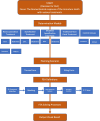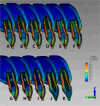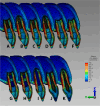Evaluatıon of stress dıstrıbutıon by applıed dıfferent forces on ımmature maxıllary central teeth wıth dıfferent treatment optıons: a laboratory fınıte element stress analysıs
- PMID: 39748342
- PMCID: PMC11697966
- DOI: 10.1186/s12903-024-05360-w
Evaluatıon of stress dıstrıbutıon by applıed dıfferent forces on ımmature maxıllary central teeth wıth dıfferent treatment optıons: a laboratory fınıte element stress analysıs
Abstract
Background: Immature maxillary central teeth can be managed by using several treatment options. The aim of this finite element stress analysis study was to evaluate the effect of different treatment procedures on the stresses on immature maxillary incisor teeth models that generated on cone beam computed tomography, by trauma and bite forces.
Methods: A total of 11 different models consisting of revascularization treatment using MTA and biodentine and the state of the root apex formed with cement after treatment, apexification, modified apexification, traditional root canal treatment and two different control groups have been created. 300N traumatic force and 240N bite force was applied with 90 and 130 angles. The stress values were examined in apical, middle and coronal sections using the finite element stress analysis method.
Results: The highest stress density was observed in the coronal root section in all models except for modified apexification treatment. While the highest vonMises stress value in coronal root dentin was found in the traditional root canal treatment group, the lowest value was found in the mature control group. In the modified apexification treatment groups, the stress was intensified in the middle and apical root section. It has been observed that in the models in which MTA is used, less stress occurs in all root parts compared to the models in which biodentine is used.
Conclusions: The use of MTA in immature teeth makes it more resistant to fracture compared to biodentine. Modified apexification method can reduce stress in the cervical area. More studies are needed on this subject.
Keywords: Apexification; Biodentine; Finite Element Stress Analysis; MTA.
© 2025. The Author(s).
Conflict of interest statement
Declarations. Ethics approval and consent to participate: Not applicable. Consent for publication: Not applicable. Competing interests: The authors declare no competing interests.
Figures







Similar articles
-
Apical Closure in Apexification: A Review and Case Report of Apexification Treatment of an Immature Permanent Tooth with Biodentine.J Endod. 2016 May;42(5):730-4. doi: 10.1016/j.joen.2016.02.007. Epub 2016 Mar 16. J Endod. 2016. PMID: 26994597 Review.
-
Effect of revascularisation and apexification procedures on biomechanical behaviour of immature maxillary central incisor teeth: a three-dimensional finite element analysis study.Clin Oral Investig. 2021 Dec;25(12):6671-6679. doi: 10.1007/s00784-021-03953-1. Epub 2021 Apr 26. Clin Oral Investig. 2021. PMID: 33899155
-
Effects of Apical Barriers and Root Filling Materials on Stress Distribution in Immature Teeth: Finite Element Analysis Study.J Endod. 2023 May;49(5):575-582. doi: 10.1016/j.joen.2023.03.009. Epub 2023 Mar 23. J Endod. 2023. PMID: 36965767
-
Outcomes of necrotic immature open-apex central incisors treated by MTA apexification using poly(ε-caprolactone) fiber mesh as an apical barrier.J Formos Med Assoc. 2019 Jan;118(1 Pt 2):362-370. doi: 10.1016/j.jfma.2018.06.008. Epub 2018 Jun 22. J Formos Med Assoc. 2019. PMID: 29937322
-
Intraradicular reinforcement of traumatized immature anterior teeth after MTA apexification.Dent Traumatol. 2024 Aug;40(4):389-397. doi: 10.1111/edt.12947. Epub 2024 Mar 8. Dent Traumatol. 2024. PMID: 38459664 Review.
References
-
- EL Nesr A. Development of teeth: Root and supporting structures. Oral Dev Histol. 2002;2:94–108
-
- Cvek M. Prognosis of luxated non-vital maxillary incisors treated with calcium hydroxide and filled with gutta-percha. A retrospective clinical study. Endod Dent Traumatol. 1992;8(2):45–55. - PubMed
-
- Camp J FA. Pediatric endodontics: endodontic treatment for the primary and young permanent dentition. In: Cohen S, Hargreaves K, Keiser K, editors. Pathways of the pulp. 9th ed. St Louis: Mosby Elsevie; 2006. p. 822–82.
-
- Banchs F, Trope M. Revascularization of immature permanent teeth with apical periodontitis: new treatment protocol? J Endod. 2004;30(4):196–200. - PubMed
Publication types
MeSH terms
Substances
Grants and funding
LinkOut - more resources
Full Text Sources
Miscellaneous

